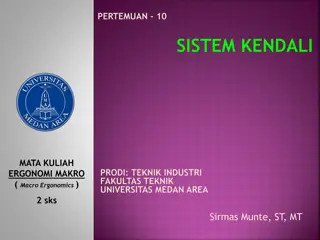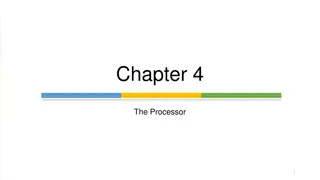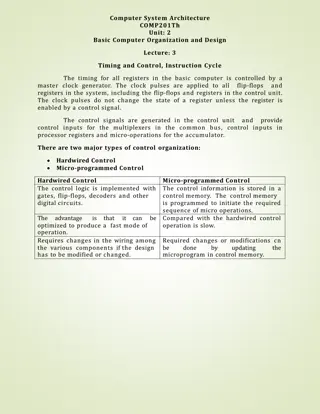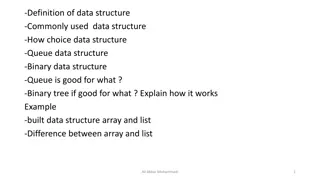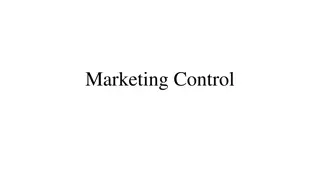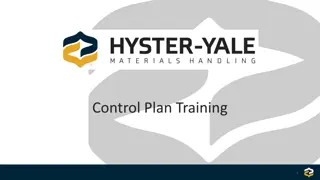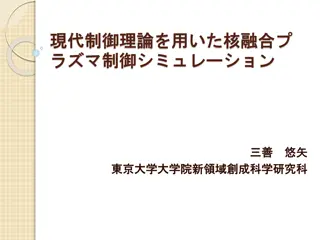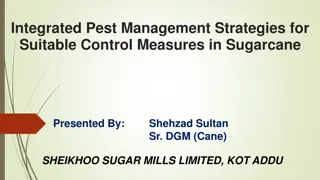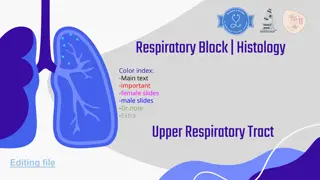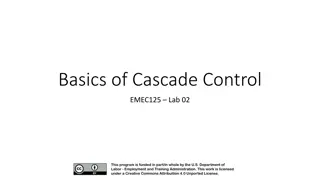Control Structures in C++ Explained
Learn about control structures in C++ such as sequential execution, selection structures (if, if/else, switch), repetition structures (while, do/while, for), C++ keywords, flowcharts for graphical representation, and how to use the if selection structure. See examples and understand how to implement these concepts in your C++ programs efficiently.
Download Presentation

Please find below an Image/Link to download the presentation.
The content on the website is provided AS IS for your information and personal use only. It may not be sold, licensed, or shared on other websites without obtaining consent from the author.If you encounter any issues during the download, it is possible that the publisher has removed the file from their server.
You are allowed to download the files provided on this website for personal or commercial use, subject to the condition that they are used lawfully. All files are the property of their respective owners.
The content on the website is provided AS IS for your information and personal use only. It may not be sold, licensed, or shared on other websites without obtaining consent from the author.
E N D
Presentation Transcript
Control Structures Decisive making in C++ Lecture 4
Control Structures Sequential execution Statements executed in order Transfer of control Next statement executed not next one in sequence 3 control structures (Bohm and Jacopini) Sequence structure Programs executed sequentially by default Selection structures if, if/else, switch Repetition structures while, do/while, for
Control Structures C++ keywords Cannot be used as identifiers or variable names C++ Keywords Keywords common to the C and C++ programming languages auto continue enum if short switch volatile C++ only keywords asm delete inline private static_cast try wchar_t break default extern int signed typedef while case do float long sizeof union char double for register static unsigned const else goto return struct void bool dynamic_cast mutable protected template typeid catch explicit false namespace new public this typename using class const_cast friend operator reinterpret_cast throw true virtual
Control Structures Flowchart Graphical representation of an algorithm Special-purpose symbols connected by arrows (flowlines) Rectangle symbol (action symbol) Any type of action Oval symbol Beginning or end of a program, or a section of code (circles)
if Selection Structure Selection structure Choose among alternative courses of action Pseudocode example: If student s grade is greater than or equal to 60 Print Passed If the condition is true Print statement executed, program continues to next statement If the condition is false Print statement ignored, program continues Indenting makes programs easier to read C++ ignores whitespace characters (tabs, spaces, etc.)
if Selection Structure Translation into C++ If student s grade is greater than or equal to 60 Print Passed if ( grade >= 60 ) cout << "Passed"; Diamond symbol (decision symbol) Indicates decision is to be made Contains an expression that can be true or false Test condition, follow path if structure Single-entry/single-exit
if Selection Structure Flowchart of pseudocode statement A decision can be made on any expression. zero - false nonzero - true Example: 3 - 4 istrue
if/else Selection Structure if Performs action if condition true if/else Different actions if conditions true or false Pseudocode if student s grade is greater than or equal to 60 print Passed else print Failed C++ code if ( grade >= 60 ) cout << "Passed"; else cout << "Failed";
if/else Selection Structure Ternary conditional operator (?:) Three arguments (condition, value if true, value if false) Code could be written: cout << ( grade >= 60 ? Passed : Failed ); Condition Value if true Value if false
if/else Selection Structure Nested if/else structures One inside another, test for multiple cases Once condition met, other statements skipped if student s grade is greater than or equal to 90 Print A else if student s grade is greater than or equal to 80 Print B else if student s grade is greater than or equal to 70 Print C else if student s grade is greater than or equal to 60 Print D else Print F
if/else Selection Structure Example if ( grade >= 90 ) // 90 and above cout << "A"; else if ( grade >= 80 ) // 80-89 cout << "B"; else if ( grade >= 70 ) // 70-79 cout << "C"; else if ( grade >= 60 ) // 60-69 cout << "D"; else // less than 60 cout << "F";
if/else Selection Structure Compound statement Set of statements within a pair of braces if ( grade >= 60 ) cout << "Passed.\n"; else { cout << "Failed.\n"; cout << "You must take this course again.\n"; } Without braces, cout << "You must take this course again.\n"; always executed Block Set of statements within braces
switch Multiple-Selection Structure Test variable for multiple values Series of case labels and optional default case switch ( variable ) { case value1: // taken if variable == value1 statements break; // necessary to exit switch case value2: case value3: // taken if variable == value2 or == value3 statements break; default: // taken if variable matches no other cases statements break; }
The following rules apply to a switchstatement The variable used in a switch statement can only be integers, convertable integers (byte, short, char), strings and enums. You can have any number of case statements within a switch. Each case is followed by the value to be compared to and a colon. The value for a case must be the same data type as the variable in the switch and it must be a constant or a literal. When the variable being switched on is equal to a case, the statements following that case will execute until abreak statement is reached.
When a breakstatement is reached, the switch terminates, and the flow of control jumps to the next line following the switch statement. Not every case needs to contain a break. If no break appears, the flow of control will fall throughto subsequent cases until a break is reached. Aswitch statement can have an optional default case, which must appear at the end of the switch. The default case can be used for performing a task when none of the cases is true. No break is needed in the default case.
public class Test { public static void main(String args[]) { // char grade = args[0].charAt(0); char grade = 'C'; switch(grade) { case 'A' : System.out.println("Excellent!"); break; case 'B' : case 'C' : System.out.println("Well done");
break; case 'D' : System.out.println("You passed"); case 'F' : System.out.println("Better try again"); break; default : System.out.println("Invalid grade"); } System.out.println("Your grade is " + grade); } }
do/while Repetition Structure do-while structure Makes loop continuation test at end, not beginning Loop body executes at least once Format do { statement } while ( condition );
1 // Fig. 2.24: fig02_24.cpp 2 // Using the do/while repetition structure. 3 #include <iostream> 4 using namespace std; 8 // function main begins program execution 9 int main() 10 { 11 int counter = 1; // initialize counter 12 13 do { 14 cout << counter << " "; // display counter 15 } while ( ++counter <= 10 ); // end do/while 16 17 cout << endl; 18 19 return 0; // indicate successful termination 20 21 } // end function main fig02_24.cpp (1 of 1) fig02_24.cpp output (1 of 1) Notice the preincrement in loop-continuation test. 1 2 3 4 5 6 7 8 9 10

 undefined
undefined









